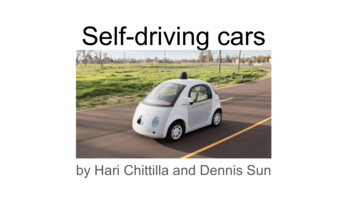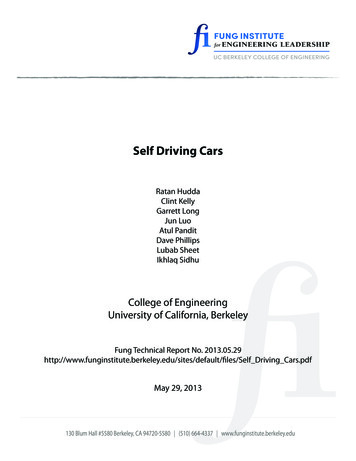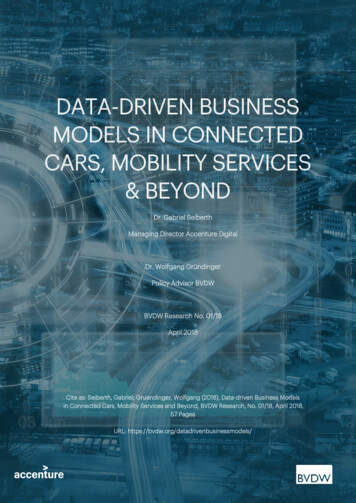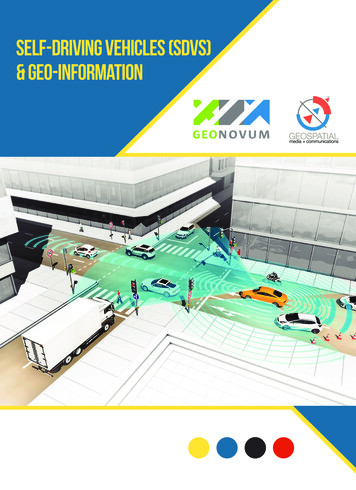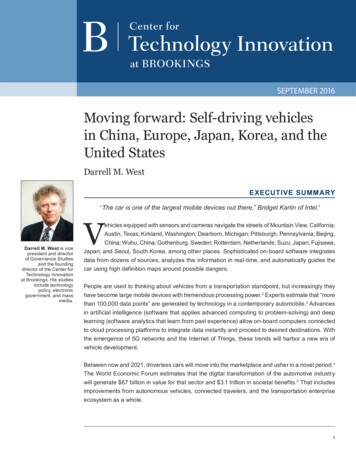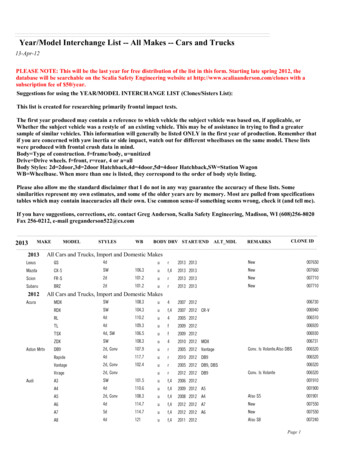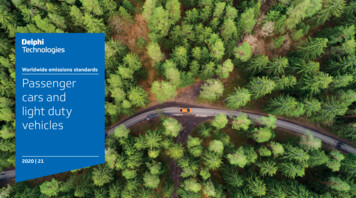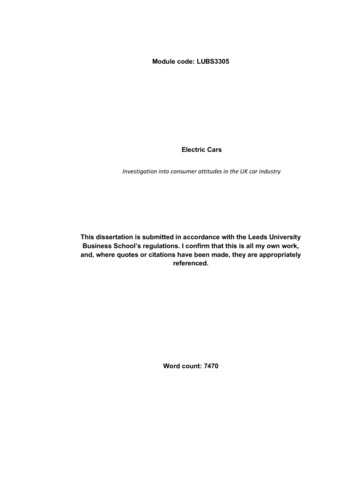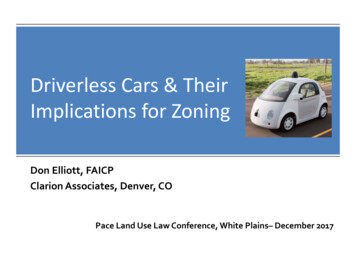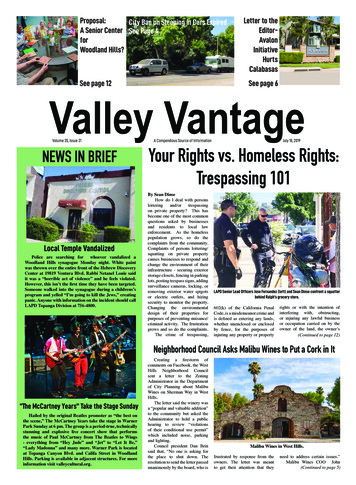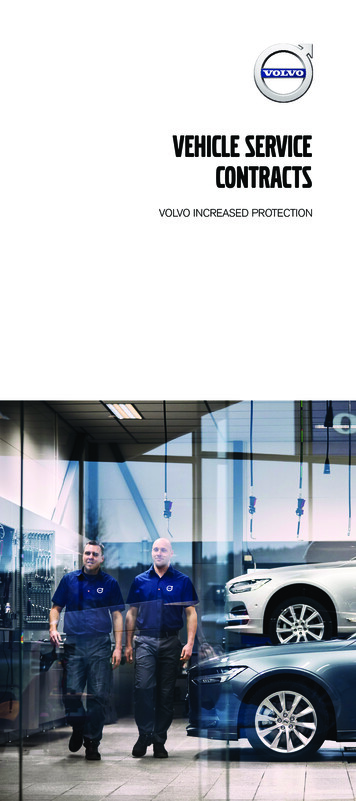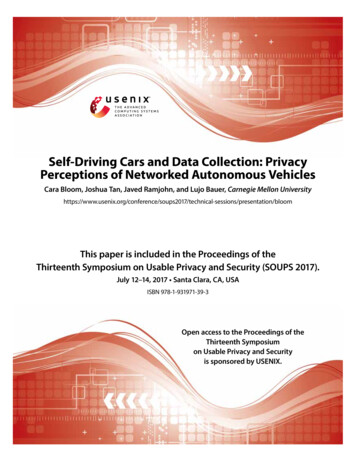
Transcription
Self-Driving Cars and Data Collection: PrivacyPerceptions of Networked Autonomous VehiclesCara Bloom, Joshua Tan, Javed Ramjohn, and Lujo Bauer, Carnegie Mellon 017/technical-sessions/presentation/bloomThis paper is included in the Proceedings of theThirteenth Symposium on Usable Privacy and Security (SOUPS 2017).July 12–14, 2017 Santa Clara, CA, USAISBN 978-1-931971-39-3Open access to the Proceedings of theThirteenth Symposiumon Usable Privacy and Securityis sponsored by USENIX.
Self-Driving Cars and Data Collection: Privacy Perceptionsof Networked Autonomous VehiclesCara BloomJoshua TanABSTRACTSelf-driving vehicles and other networked autonomous robotsuse sophisticated sensors to capture continuous data aboutthe surrounding environment. In the public spaces whereautonomous vehicles operate there is little reasonable expec tation of privacy and no notice or choice given, raising pri vacy questions. To improve the acceptance of networked au tonomous vehicles and to facilitate the development of tech nological and policy mechanisms to protect privacy, publicexpectations and concerns must first be investigated. In astudy (n 302) of residents in cities with and without Uberautonomous vehicle fleets, we explore people’s conceptionsof the sensing and analysis capabilities of self-driving ve hicles; their comfort with the di erent capabilities; and thee ort, if any, to which they would be willing to go to opt outof data collection. We find that 54% of participants wouldspend more than five minutes using an online system to optout of identifiable data collection. In addition, secondary usescenarios such as recognition, identification, and tracking ofindividuals and their vehicles were associated with low like lihood ratings and high discomfort. Surprisingly, those whothought secondary use scenarios were more likely were morecomfortable with those scenarios. We discuss the implica tions of our results for understanding the unique challengesof this new technology and recommend industry guidelinesto protect privacy.1.INTRODUCTIONNetworked autonomous robots in the form of drone swarmsand commercial autonomous vehicles (AVs) are being re searched, tested, and deployed. This technology is set tofundamentally shift common daily practices such as the useand ownership of automobiles [52]. At the time of data col lection, Uber’s self-driving car fleet had been deployed inPittsburgh, PA for five months and was planning to expandto other states. The fleet is large enough that seeing theAVs has become quotidian to residents.Two ethical concerns with the growing prevalence of AVshave received significant attention in the media and aca-Copyright is held by the author/owner. Permission to make digital or hardcopies of all or part of this work for personal or classroom use is grantedwithout fee.Symposium on Usable Privacy and Security (SOUPS) 2017, July 12–14,2017, Santa Clara, California.USENIX AssociationJaved RamjohnCarnegie Mellon UniversityLujo Bauerdemic discourse. Ethical decision making—especially con cerns with life-or-death decisions made by AVs—has beena major focus and has influenced public willingness to ac cept AVs as decision makers [41]. Commercial drivers, laboreconomists, and corporations have focused on the markete ects of robots taking human jobs, both positive and neg ative [53]. A third ethical concern, and the focus of thispaper, is the privacy-invasive capabilities of AVs, as well asthe potential security risks associated with AV data collec tion. This ethical concern has received very little attentionrelative to decision-making and labor market changes.Commercial fleets of networked AVs have the capability tocollect location and movement data about residents of an en tire city simply by storing the information already capturedby their many sensors and using available software to ana lyze it. This capability poses a new regulatory conundrum,as it combines four di erent aspects of privacy-invasive tech nologies: (1) the ubiquitous capture of data in public, (2)physical surveillance by a privately owned company, (3) theability to scale without additional infrastructure, and (4)the difficulty of notice and choice about data practices forphysical sensors that capture data about non-users. Ubiqui tous data collection in public has been implemented by citiessuch as London [48], which has sparked public debate overthe efficacy and morality of surveillance. While cities arebeholden to their constituents and residents, companies arebeholden to their shareholders [13]. If a city like London anda company like Uber have the same data set of geo-temporalpoints, the former has an obligation to use it to better itsconstituents and the latter has an obligation to monetize it,bettering its shareholders.While similar issues also apply to CCTV and dashboardcameras, the scalability and potential ubiquity of a net worked self-driving car fleet is remarkable. Unlike CCTV,AVs can increase the bounds of their surveillance without ad ditional infrastructure and can cover any public roads theyare legally permitted to drive on. They use public infras tructure and are not reliant on privately owned property.The networked aspect di erentiates them from dashboardcameras or individual self-driving cars (such as future Fordsor Teslas) due to the scale of data collection and analyticcapabilities on such aggregated sensor data.These vehicles operate in public spaces where individualsdo not have a reasonable expectation of privacy, and wherenotice and choice would be difficult to provide. Internet ofthings (IoT) devices such as Alexa already su er from thedifficulty of sufficiently notifying users of data collection (noThirteenth Symposium on Usable Privacy and Security357
screen means no terms and conditions to read on the device),a task made more difficult when devices collect data fromnon-users [40]. Autonomous vehicles on public roads areconstantly interacting with non-users: people who have notconsented to any data collection or use and, as demonstratedin our study, have not yet thought about the potential pri vacy impacts.self-driving vehicles are, and how comfortable they are withthose capabilities. Scenarios were framed using the Uberself-driving car fleet as an example. We recruited in Pitts burgh where the fleet has been deployed since September2016 in addition to four other cities to investigate whetherexposure to the technology changed conceptions or senti ments.As with many powerful new technologies, the large-scalecapture and analysis of data enabled by AVs could lead toboth benefits to the public and concerns. Ubiquitous sensingcapabilities could be used to find Amber or Silver Alert citi zens [48], but the same technology could also be used for lessaltruistic purposes. Insurers might analyze license plate logsto find out whether a customer speeds on the highway andadjust her car insurance rates accordingly, countries couldidentify dissidents, or an employee of the AV company coulduse the technology to stalk a celebrity or an ex-girlfriend, asUber employees were found doing [7]. AV sensors could logthe physical movements of every person within the purviewof the fleet, making it possible to find anyone anywhere.The chilling e ects of such surveillance and related dangersof ubiquitous data collection are well documented in privacyand security literature [39].In addition to questions about likelihood and comfort withprivacy capabilities, participants answered questions aboutgeneral AV technology concerns like safety, their exposureto self-driving cars, bias against Uber, and demographic in formation. Responses were analyzed to determine likelihoodand comfort levels as well as the relationship between likeli hood, comfort, and potential explanatory variables.Reasonable expectation, unfairness, and deception are cen tral themes for privacy regulation in the United States, soone key question is: where does the public draw the line be tween acceptable and unacceptable practices for autonomousnetworked robots? New technologies such as the Internetand more recently the Internet of Things can outpace thecreation of reasonable privacy standards as they are quicklyintegrated into people’s daily lives, leading to many inven tive studies of the gaps in protection and how to patch them(e.g., [28, 17]). Users of these technologies can become ha bituated to the lack of privacy [51], making usable, e ectiveprivacy protections more difficult to enact. Therefore, it isimportant to explore privacy conceptions and strategies forprivacy protection during the earliest phases of a new tech nology’s implementation, before deployment outpaces theincorporation of privacy.Whereas other potentially privacy-invasive technologies haverequired users opt in, AVs cannot give all pedestrians anddrivers they encounter notice and choice. Companies oper ating such fleets could potentially o er notice outside of theinformation capture environment, but it would be difficultto give people the choice to opt out of information collectionin all forms. Some information would have to be collectedduring the opt-out process, such as a license plate numberto opt out of license plate recognition. Other options suchas an opt-in process, privacy policies that limit the use ofcollected data, or even the removal of identifiable markersfrom stored data, are possible approaches. To make rec ommendations to the few companies currently operating inthe space of networked AVs, privacy conceptions about thetechnology and its potential uses must first be understood.Our investigation aims to fill this gap by exploring concep tions of the sensing and analysis capabilities of AVs; people’scomfort with the di erent capabilities; and the e ort, if any,to which they would be willing to go to opt out of data col lection. We ran an online study of 302 participants usingscenarios of increasing privacy invasiveness to measure howlikely participants thought di erent potential capabilities of358Thirteenth Symposium on Usable Privacy and SecurityWe found that participants consider primary uses of AV sen sors such as data collection, aggregation, storage, and anal ysis by the cars to be likely, and that participants expressmoderate comfort with these scenarios. Secondary use sce narios such as the recognition, identification, and trackingof individuals or their vehicles received the lowest ratingsof likelihood and highest discomfort. Surprisingly, partici pants who thought the technology was more likely to have aprivacy-invasive capability such as tracking were more likelyto be comfortable with that capability. Though participantsrated many capabilities likely and expressed high levels ofdiscomfort, only one out of three would spend more than 10minutes using an online opt-out system.Pittsburgh participants who had exposure to the Uber selfdriving car fleet (over 60% had seen one compared to 3%for other cities) were not statistically di erent in their con ceptions of likelihood and comfort from residents of othercities who had never seen a self-driving car. The only fac tor that showed a significant increase in opt-out time waswhether participants had received the privacy scenario prim ing questions, which participants noted had raised difficultquestions they had not considered before. If public atten tion surrounding AVs expands from safety and employmentissues to privacy issues, our findings suggest that peoples’overall comfort with AVs may increase, but so might privacyseeking behavior as well. Understanding the complex pri vacy concerns in this space is essential for developing indus try practices and regulation.2.BACKGROUND AND RELATED WORKThe classic work in the area of AVs and privacy discussesthe privacy implications for owners and users of AVs in de tail and alludes to surveillance, noting that “[networked] au tonomous vehicles could enable mass surveillance in the formof comprehensive, detailed tracking of all autonomous ve hicles and their users at all times and places.” The workfocuses solely on the passengers within an AV who haveostensibly agreed to the terms and conditions, legally re linquishing their privacy the same way consumers do whenusing Google Maps [16]. In this paper we assess the morecomplex privacy concerns of those who interact with AVs,but are not necessarily users of the system. We next reviewconsumer perception of AVs, followed by their technologicalcapabilities and relevant regulations.2.1 Consumer PerceptionResearch into consumer perceptions of AVs has examinedgeneral interest, trust in the cars’ reliability and safety, andUSENIX Association
consumer feelings about how self-driving cars could impactthe job market. Our work is one of the few that focuses onconsumer privacy concerns and preferences regarding selfdriving cars.Consumer perception has been a popular area of discussionand research, given its potential impact on sales and marketadoption. With AVs being deployed in test locations andviable plans to bring them to mass-market, studies have beenconducted to gauge consumer interest. Schoettle and Sivakfound that people are generally uninformed and had bothhigh expectations about the benefits of autonomous vehiclesand high levels of concern about riding in them. Additionalconcerns were changes to the job market, security againsthacking, and data privacy concerns such as location anddestination tracking [41]. This was one of the only studiesof AVs that discussed data privacy, and it was not one ofthe central research questions.In a Kelley Blue Book study (n 2000, weighted to censusfigures), 62% of participants did not want a world with solelyAVs, with resistance decreasing with age [26], a trend corrob orated by other studies of autonomy and age [1]. While theseresults shed insight into consumer preferences, this studywas potentially biased by the extremity of its scenario, pre senting a world with only autonomous cars to participantswho likely live in an
screen means no terms and conditions to read on the device), a task made more dicult when devices collect data from non-users [40]. Autonomous vehicles on public roads are
